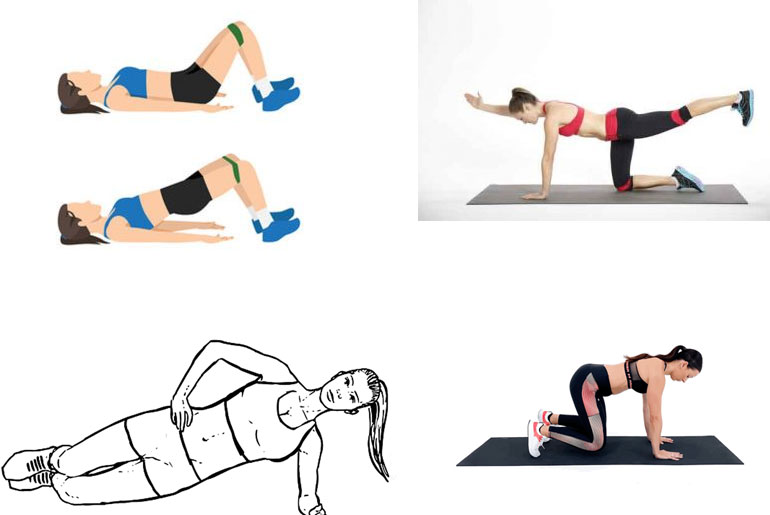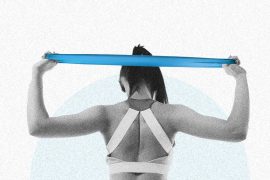Strengthening your core muscles is vital for overall movement and stability. The importance of the core as the foundation for all movements. Comprising abdominal muscles, the pelvic floor, spine, and hips, the core stabilizes and controls the pelvis and spine, influencing upper and lower body movements. By bracing the core, you can prevent strain on the lower back during activities like lifting heavy objects, reducing the risk of injury and pain.
A strong core can help prevent back pain and injury, crucial for maintaining mobility as you age. Additionally, strong core muscles improve balance, stability, and posture, making everyday activities easier and enhancing performance in fitness pursuits. In sports such as running, strong abdominal muscles aid in maintaining an upright torso, even when fatigued, which can prevent inefficient movement patterns.
Research supports the benefits of core training for performance enhancement. A study on male college athletes revealed that those who underwent an eight-week core training program experienced significant improvements in running economy, a key factor in running performance. Conversely, athletes who did not engage in core training did not show similar improvements. Therefore, prioritizing core strength can lead to enhanced athletic performance and overall well-being.
Bodyweight Core Workout for Beginners:
Ready to begin strengthening your core? This beginner-friendly workout, designed by Lapaix, features five simple yet effective exercises that target your abdominal muscles. These exercises are strategically chosen to activate your core while minimizing room for error in form.
All you need for this routine is a yoga or exercise mat. Perform each exercise for 30 to 45 seconds, followed by a 15-second rest before moving on to the next exercise. Start with one set, totaling about 7 minutes, and gradually increase to four sets as you progress and get stronger.
For optimal results, aim to perform this routine three to four times per week on nonconsecutive days. However, remember that a well-rounded fitness routine should also include cardio and strength exercises that target all major muscle groups.
Before starting any new exercise regimen, especially if you have underlying health conditions, it’s important to consult with your doctor for clearance. This is particularly crucial if you have back pain or injury, are recovering from abdominal surgery, are pregnant, or have recently given birth. Safety first ensures that you can reap the benefits of this core workout while minimizing any potential risks.
1. Dead Bug:
This exercise is called the Dead Bug. Here’s a step-by-step guide to perform it correctly:
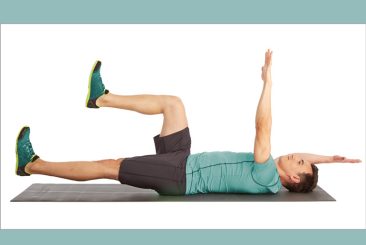
- Lie faceup on the floor with your arms extended toward the ceiling, perpendicular to the floor.
- Bend your knees and raise them so that they form a 90-degree angle, with your shins parallel to the floor.
- Engage your core muscles by bracing them, and press your lower back firmly into the floor to stabilize your spine.
- Slowly extend your left leg straight out in front of you, while simultaneously reaching your right arm straight back behind you. Both the extended arm and leg should hover just a few inches above the ground.
- Hold this position for a moment, focusing on maintaining stability through your core.
Return to the starting position by bringing your left leg and right arm back to the initial position.
- Repeat the movement on the opposite side by extending your right leg and left arm.
Continue alternating sides in a controlled manner, focusing on keeping your core engaged and your lower back pressed into the floor throughout the exercise.
Perform the Dead Bug exercise for 30 to 45 seconds, then rest for 15 seconds before moving on to the next exercise in your core workout routine.
2. Glute Bridge:
The Glute Bridge exercise targets your glute muscles and helps strengthen your core. Here’s how to perform it correctly:
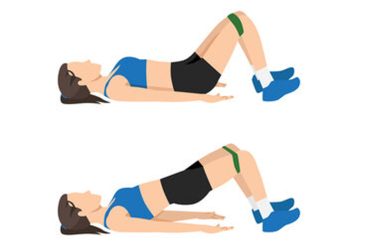
- Lie on your back with your arms down by your sides.
- Bend your knees and place both feet flat on the floor, hip-width apart. Your heels should be positioned about six to eight inches away from your glutes, and your toes should be pointing forward.
- Engage your abdominal muscles by pulling your belly button towards your spine.
Squeeze your glute muscles and lift your hips toward the ceiling, pushing through your heels.
- Only lift your hips as high as you can without arching your back. Your body should form a straight line from your knees to your hips to your shoulders.
- Hold the top position for two seconds, focusing on squeezing your glutes.
- Slowly lower your hips back down to the floor with control.
- Repeat the movement for the desired number of repetitions.
Make sure to maintain proper form throughout the exercise and avoid overarching your back or allowing your knees to collapse inward. This exercise can be performed for 30 to 45 seconds, followed by a 15-second rest before moving on to the next exercise in your core workout routine.
3. Bird Dog:
The Bird Dog exercise is excellent for improving core stability and strengthening your back muscles. Here’s how to perform it correctly:
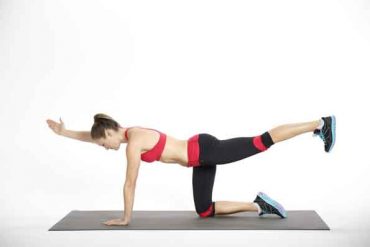
- Start on your hands and knees on the floor, with your wrists stacked directly under your shoulders and your knees under your hips. Your spine should be in a neutral position, forming a straight line from your head to your tailbone.
- Engage your core muscles to stabilize your torso.
- Extend your left arm straight out in front of you, parallel to the floor, while simultaneously extending your right leg straight out behind you, also parallel to the floor. Keep your hips level throughout the movement, avoiding any rotation or tilting.
- Hold this position briefly, focusing on maintaining stability through your core and keeping your back flat.
- Slowly return your left hand and right knee to the starting position on the floor.
- Repeat the movement on the opposite side by extending your right arm and left leg straight out.
- Continue alternating sides in a controlled manner, focusing on keeping your core engaged and your body stable throughout the exercise.
Perform the Bird Dog exercise for 30 to 45 seconds, then rest for 15 seconds before moving on to the next exercise in your core workout routine.
4. Bear Plank with Knee Taps:
The Bear Plank with Knee Taps is an effective core exercise that also engages your shoulders, arms, and legs. Here’s how to perform it correctly:
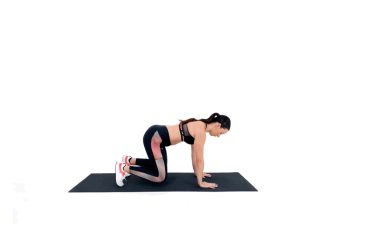
- Start on your hands and knees on the floor, with your wrists stacked directly under your shoulders and your knees under your hips. Your spine should be in a neutral position, forming a straight line from your head to your tailbone.
- Press your palms into the floor and engage your abdominal muscles by pulling your belly button towards your spine.
- Lift your knees about an inch off the floor, keeping your back flat and your hips in line with your shoulders and knees. This is your starting position.
- While maintaining a stable core and keeping your hips steady, alternate tapping the floor with one knee at a time.
- Tap the floor lightly with your knee and then return it to the starting position, maintaining control and stability throughout the movement.
- Keep your head in line with your spine throughout the exercise, avoiding any excessive tilting or lifting.
- Continue alternating knee taps for the desired number of repetitions or time interval.
If you experience discomfort or pain in your wrists while performing this exercise, you can modify it by forming fists with your hands instead of placing your palms on the floor. This can help alleviate wrist strain while still allowing you to engage your core effectively. Perform the Bear Plank With Knee Taps for 30 to 45 seconds, then rest for 15 seconds before moving on to the next exercise in your core workout routine.
5. Modified Side Plank:
The Modified Side Plank is a great exercise for strengthening your core, particularly targeting the muscles on the side of your torso. Here’s how to perform it correctly:
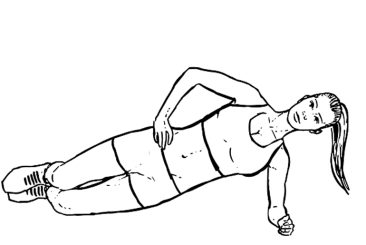
- Lie on your right side on the floor, with your knees bent and your feet positioned behind you. Your legs should be stacked on top of each other.
- Place your right forearm on the ground, positioning your elbow directly underneath your shoulder.
- Engage your core muscles by pulling your belly button towards your spine.
- Press through your right forearm and knee to lift your upper body off the ground, supporting yourself on your right arm and knee. Your body should form a straight line from your head to your knee.
- Keep your hips lifted and your core engaged throughout the exercise to maintain stability.
- Hold this position for 30 to 45 seconds, focusing on keeping your body aligned and your muscles engaged.
- After completing the designated time, slowly lower your hips back down to the floor.
Repeat the exercise on the opposite side by lying on your left side and supporting yourself with your left forearm and knee.
Perform the Modified Side Plank for 30 to 45 seconds on each side, then rest for 15 seconds before moving on to the next exercise in your core workout routine. This exercise helps strengthen the muscles along the side of your body, promoting better stability and posture.
Disclaimer:
The information contained in this article is for educational and informational purposes only and is not intended as a health advice. We would ask you to consult a qualified professional or medical expert to gain additional knowledge before you choose to consume any product or perform any exercise.

